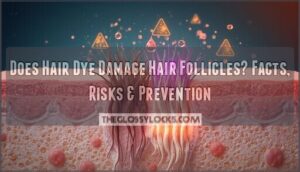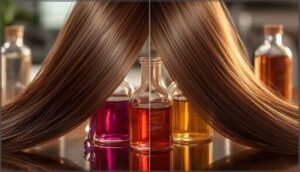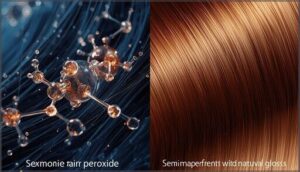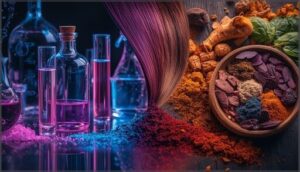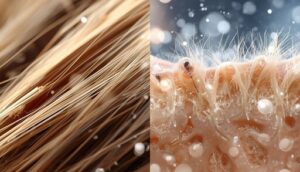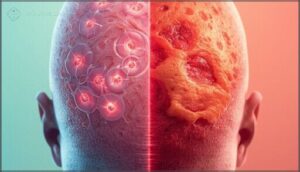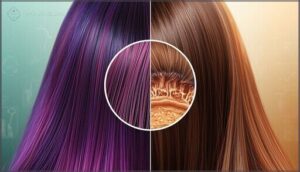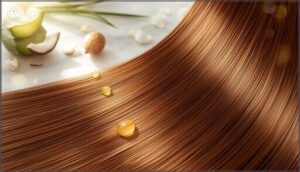This site is supported by our readers. We may earn a commission, at no cost to you, if you purchase through links.
You’ve probably noticed the warning labels on hair dye boxes or heard someone swear they lost hair after coloring. The truth is more nuanced than the horror stories suggest. Hair dye doesn’t usually damage the follicles themselves—those living roots buried beneath your scalp—but it can create conditions that weaken them indirectly.
The real risk depends on what’s in your dye, how often you use it, and whether your scalp can handle the chemical exposure. Some people color their hair for decades without issue, while others develop reactions that disrupt the entire follicular environment.
Understanding the difference between surface-level hair damage and actual follicle harm helps you make smarter choices about coloring your hair safely.
Table Of Contents
- Key Takeaways
- Does Hair Dye Damage Hair Follicles?
- Hair Dye Ingredients That Affect Hair Health
- Types of Hair Dye and Their Effects
- Difference Between Hair Breakage and Hair Loss
- Allergic Reactions and Scalp Irritation
- Can Hair Dye Cause Permanent Hair Loss?
- Preventing Hair Follicle Damage From Dye
- Repairing Hair and Follicle Health After Dye
- Frequently Asked Questions (FAQs)
- Conclusion
Key Takeaways
- Hair dye primarily damages the hair shaft rather than the follicles themselves, though severe scalp reactions or chemical burns can indirectly stress follicles and disrupt growth cycles.
- Permanent dyes containing ammonia and hydrogen peroxide pose higher risks than semi-permanent or plant-based alternatives, with PPD causing allergic reactions in 0.8-1.5% of users.
- Genetic variants like NAT2 or CYP1A2 increase your follicular damage risk by 2.5 times, while dyeing every five to eight weeks raises harm by 60%.
- Most dye-related hair loss is temporary and reversible within three to six months after stopping exposure, though severe burns can cause permanent scarring alopecia.
Does Hair Dye Damage Hair Follicles?
Hair dye doesn’t usually damage the follicle itself because it mainly works on the hair shaft above the skin. However, certain ingredients and application methods can affect your scalp and indirectly put stress on the follicles below.
Let’s look at how dye interacts with your hair and scalp, what exposure really means, and which factors increase your risk.
How Hair Dye Interacts With Hair and Scalp
When hair dye touches your scalp, most chemical reactions happen on the hair shaft itself—not inside the follicle. Dye penetration depends on the product type and how it’s applied.
Here’s what occurs during the coloring process:
- Hair dye ingredients like ammonia lift the cuticle to allow color molecules inside
- Hydrogen peroxide bleaches your natural pigment through oxidation
- Scalp absorption remains minimal, with less than 0.04 µg/cm² reaching deeper skin layers
- Most dye residue stays in non-living outer skin cells
- Chemical reactions primarily alter the hair fiber structure rather than living follicle tissue
To reduce potential issues, consider using gentle hair dyes.
Direct Vs. Indirect Follicle Exposure
Direct contact happens when hair dye touches your scalp during application—about 65% of contact dermatitis cases involve these areas. Dye penetration into follicle openings can reach 5% of what you apply, staying detectable for up to 48 hours.
Indirect exposure occurs through rinsing or transfer, affecting adjacent regions and causing scalp irritation in 20-35% of users over repeated sessions. Repeated dyeing can lead to roughening of hair.
Risk Factors for Follicle Damage
Your genetic makeup plays a bigger role than you might think. If you carry NAT2 or CYP1A2 slow variants, you face 2.5 times higher follicular damage risk from permanent dyes.
If you carry NAT2 or CYP1A2 slow variants, you face 2.5 times higher follicular damage risk from permanent dyes
Dye frequency matters too—coloring every five to eight weeks increases harm by 60%.
Pre-existing scalp conditions like dermatitis, hormonal shifts, and starting before age 30 all increase chemical exposure risks to your follicles.
Hair Dye Ingredients That Affect Hair Health
Not all hair dye ingredients are created equal. Some chemicals are designed to change your hair color quickly and permanently, but they can also weaken your strands and irritate your scalp.
Here’s what you need to know about the most common ingredients and how they affect your hair health.
Ammonia and Hydrogen Peroxide Effects
Permanent dyes rely on two powerful chemicals to lock in color, but they don’t come without a cost. Ammonia raises your hair’s pH to around 9–10, forcing the cuticle open so color can sink into the cortex. Meanwhile, hydrogen peroxide breaks down your natural pigment and weakens the protein structure inside each strand.
- Ammonia usually sits at 1–3% in most commercial dyes
- Peroxide concentrations usually range from 6–9%
- Repeated ammonia exposure roughens hair and reduces tensile strength
- Hydrogen peroxide causes protein loss that worsens with each application
These chemicals mainly target your hair shaft, but when they touch your scalp during application, they can trigger irritation or dermatitis. Studies show peroxide inhibits follicle growth in lab settings, and animal research links dye mixtures to visible hair loss and inflammation. The good news? Most scalp reactions clear up once you stop using the product, though chronic irritation may create longer-term concerns.
Paraphenylenediamine (PPD) Risks
PPD—short for paraphenylenediamine—sits at the heart of many allergic reactions to permanent dye. Anywhere from 0.8% to 1.5% of people in Europe develop contact dermatitis from PPD exposure, though hairdressers face a risk more than five times higher.
Symptoms often show up 24–72 hours after you apply dye—think itching, redness, swelling, or even angioedema in severe cases.
Plant-Based and Ammonia-Free Dyes
If you’re looking for hair dye alternatives that spare your scalp, plant-based colors and ammonia-free formulas deliver gentler chemical composition. Studies on 50 people using ammonia-free dye showed zero cases of contact dermatitis and 87% shinier hair. Natural dyes rarely reach follicles, and user satisfaction sits at 90% for organic dyes.
Safety profiles confirm these options protect follicle interaction:
- MEA-based ammonia-free dyes don’t open the cuticle as deeply as traditional formulas
- Anthocyanin plant dyes last up to five washes with no follicle injury reported
- Market trends show 25% of retail hair color now uses ammonia-free technology
- Only 0.12% of adverse events involve suspected follicle disturbances from these products
- Shikonin-based natural dyes offer antibacterial benefits without scalp harm
Types of Hair Dye and Their Effects
Not all hair dyes work the same way. Some penetrate deep into your hair’s structure, while others coat the surface.
Understanding the differences between dye types can help you choose what’s safest for your hair and scalp.
Permanent Vs. Semi-Permanent Dyes
When you’re deciding between permanent hair dyes and semipermanents, understanding their chemical penetration matters for hair follicle damage prevention. Permanent hair dyes cause deeper structural alteration through oxidation—using ammonia and peroxide—which increases health risks like scalp burns.
Semipermanents skip harsh chemicals, reducing hair dye effects but requiring higher application frequency.
Consumer trends now favor gentler options as awareness grows about types of hair dye damage.
Temporary and Natural Dyes
If you want the gentlest route, temporary dyes and natural options barely touch your hair follicles. Temporary dye effects include surface coating that washes out in one or two shampoos, with measurable hair damage in under 5% of users.
Natural dyes like henna show no follicle irritation risk in most studies and preserve hair strength. Plant-based allergies remain rare—around 0.3% incidence—making dye frequency impact minimal even with monthly use.
Chemical Vs. Organic Dye Options
The global plant-based hair dye market hit $2 billion in 2025 and should reach $3.8 billion by 2033—a sign consumers want better dye ingredient safety.
Yet organic dye efficacy often lags behind: chemical dyes deliver stronger color uptake and longer-lasting coverage than most natural dyes.
Regulatory standards and labeling transparency remain uneven, so “organic” doesn’t always mean free from chemical dye risks.
Difference Between Hair Breakage and Hair Loss
When your hair starts thinning after dyeing, it’s not always clear what’s actually happening. You might be dealing with breakage—where the hair shaft snaps—or true hair loss from the follicle itself.
Understanding the difference helps you figure out what’s fixable and what needs a different approach.
Damage to Hair Shaft Vs. Follicle
When you apply hair dye, the chemical processes target your hair shaft—not the follicle itself. Research shows cuticle damage occurs most often, causing structural changes like breakage and thinning. Your follicles have natural follicle shielding, staying protected beneath the scalp. However, severe cases like scalp burns can injure follicles. Most hair dye damage affects the shaft, while follicle damage remains rare.
- Cuticle lifting weakens your hair shaft during dyeing
- Follicle shielding keeps roots protected under normal use
- Scarring from burns represents the main risk to follicles
Recognizing Signs of Each Type
You can spot breakage by checking for mid-shaft snapping and split ends—your strands will feel brittle and lack elasticity in about 68% of cases. Loss indicators include hair shedding at the root, often appearing in your sink within a week of dyeing.
Scalp symptoms like redness or flaking signal potential follicular damage. Trichoscopic markers, such as exclamation mark hairs and black dots, help distinguish breakage from true follicle loss.
Causes Linked to Dye Use
Chemical penetration from permanent dyes triggers oxidative damage that disrupts your growth cycle and causes follicle weakening. Allergic reactions to hair dye ingredients like PPD inflame the scalp, loosening roots and accelerating telogen effluvium in up to 20% of chronic users.
Repeated ammonia and peroxide exposure creates chemical damage to hair proteins, increasing breakage risk while indirect stress compromises follicle recovery capacity.
Allergic Reactions and Scalp Irritation
Hair dye doesn’t just damage the hair shaft—it can also trigger reactions on your scalp that create real problems for your follicles. These reactions range from mild irritation to severe allergic responses that affect how well your hair grows.
Let’s look at the most common types of scalp reactions and what they mean for your follicle health.
Symptoms of Hair Dye Allergies
When allergic reactions to hair dye strike, you’ll usually notice itching and rash within 48 hours of application. Swelling symptoms may develop around your scalp, face, eyelids, or ears.
Some people experience mild skin irritation or contact dermatitis, while roughly 9% face severe complications requiring hospital care.
Misdiagnosis risks are high—up to 80% of cases get initially mistaken for other conditions before proper allergy testing confirms the cause.
Contact Dermatitis and Chemical Burns
Beyond simple allergic reactions, contact dermatitis and chemical burns can develop when PPD allergy triggers overlap with irritant damage from dye ingredients. Patch testing beforehand helps predict reaction patterns, though burn severity depends on application time and concentration.
These chemical burns appear as red, swollen, weeping scalp irritation—sometimes alongside the allergic reaction itself—requiring immediate medical attention to prevent deeper tissue damage.
How Scalp Health Impacts Follicles
Inflammation from dye reactions doesn’t stop at the surface—it disrupts the entire follicular environment. When your scalp stays inflamed, it shifts follicles from active growth into early shedding phases and can gradually shrink follicle size over time.
- Microbiome balance changes across your whole scalp during chronic irritation, not just where thinning shows
- Sebum production rises with inflammation, creating a cycle of microbial overgrowth that stresses roots further
- Nutrient delivery weakens when inflamed blood vessels fail to supply follicles properly
Early treatment protects follicles from permanent damage.
Can Hair Dye Cause Permanent Hair Loss?
Good news: hair dye almost never causes permanent hair loss. Most damage affects the hair shaft itself, not the follicles beneath your scalp.
Let’s look at what’s temporary, what’s not, and when you should talk to a professional.
Temporary Vs. Permanent Follicle Damage
Most hair dye reactions trigger temporary hair loss that resolves once you stop exposure. Your follicles usually recover within a few months as inflammation settles.
Permanent hair loss from hair dye is rare but can happen when severe allergic reactions cause scarring alopecia. Damage reversibility depends on inflammation severity and exposure frequency—mild irritation heals completely, while deep chemical burns may destroy hair follicles permanently.
Regrowth Timeline and Expectations
If you stop dyeing your hair, you can expect new baby hairs within one to three months as your hair growth cycle resumes. Complete recovery of volume and hair follicle health generally takes three to six months. Your regrowth rate and root touch-ups will improve as damage recovery continues. Treatment impact varies, but following these steps accelerates hair recovery:
- Stop chemical exposure immediately
- Massage your scalp daily
- Use gentle, nourishing products
- Avoid excessive heat styling
- Consider professional hair loss recovery timeline guidance
When to Seek Professional Help
You should consult a dermatologist or trichologist if scalp reaction severity includes persistent redness, blisters, or drainage lasting beyond two days. Chemical burn signs—pain, open sores, or discharge—require immediate attention.
When persistent hair shedding or unexplained hair thinning continues past normal cycles, hair restoration experts can diagnose underlying causes.
If allergy symptoms worsen or breathing becomes difficult, seek emergency care.
A consultation for hair loss ensures proper treatment and prevents permanent damage.
Preventing Hair Follicle Damage From Dye
You don’t have to give up color to protect your hair follicles. The right approach can reduce your risk of damage and keep your scalp healthier in the long run.
Here’s what really matters when you’re choosing and using hair dye.
Choosing Safer Hair Dye Products
You can reduce your risk by reading the ingredient list before you buy. Look for ammonia-free formulas and plant-based colors that skip harsh chemicals like paraphenylenediamine (PPD) and resorcinol. Temporary or semi-permanent dyes generally contain fewer irritants than permanent ones.
Brands highlighting ingredient transparency and regulatory updates often undergo safety testing, though even “natural” products may include some synthetic agents for effective results.
Minimizing Chemical and Heat Exposure
Stretch out time between dye sessions to limit chemical damage. Cutting application time by 25% per session also lowers exposure without sacrificing coverage. Ammonia-Free Dyes and techniques like the Balayage Technique keep chemicals away from your scalp.
Heat Protectants shield strands before heat styling, while Shower Filters remove chlorine that worsens irritation.
Small adjustments in your hair care routine add up to real hair loss prevention and long-term hair product benefits.
Repairing Hair and Follicle Health After Dye
If your hair and scalp have taken a beating from dye, the good news is that most damage can be reversed with the right approach. Recovery involves both at-home care and professional options that target different aspects of healing.
Here’s how you can support your hair’s return to health and encourage new growth.
Nourishing Hair Care and Scalp Massage
After dye damage, your scalp health depends on what you feed it. Nutrient-rich hair products containing protein and antioxidants can improve thickness and strength within weeks—one study found botanical treatments boosted growth speed considerably.
Daily scalp massage for 11–20 minutes increases blood flow by up to 40%, delivering oxygen and clearing chemical buildup while supporting your hair care routine and post-dye recovery.
Professional Treatments (Minoxidil, PRP)
When home care isn’t enough, professional hair loss treatments like Minoxidil and PRP therapy step in. Both options have strong safety profiles and work best when started early, giving you real paths to recovery.
Minoxidil achieves visible results within 8 weeks, with 5% solutions showing 45% better regrowth than lower concentrations. PRP increases hair density by 31% after six months and earns a 76% satisfaction rate.
Tips for Supporting Regrowth and Recovery
While Minoxidil and PRP deliver clinical results, your daily choices can accelerate recovery. Small lifestyle changes protect your hair follicles from ongoing chemical stress and create the foundation for lasting hair regrowth.
Here’s what works:
- Dietary adjustments: Consume protein at each meal and add fatty fish twice weekly to fuel follicle repair
- Scalp care: Massage weekly and wash with lukewarm water to boost circulation
- Professional guidance: Consult a dermatologist if regrowth stalls beyond six months
- Lifestyle changes: Take hair supplements for hair loss targeting iron, vitamin D, and biotin deficiencies
These hair regrowth treatments form your hair loss recovery timeline.
Frequently Asked Questions (FAQs)
Can hair dye affect hair growth rate?
No, hair dye doesn’t slow down hair growth from the follicles. Any hair loss you see comes from breakage along the hair shaft, not changes to the follicle’s normal growth cycle.
Does frequent dyeing weaken the hair shaft permanently?
Your shaft might survive one coloring, yet face permanent changes after three or more sessions. Chemical damage to hair alters cuticle structural changes, mechanical property shifts, and chemical composition alteration progressively.
Damage reversibility depends on dyeing frequency impact and minimizing hair breakage.
Are there genetic factors in dye-related damage?
Yes. Genetic differences shape how your scalp reacts to hair dye. FLG mutations weaken your skin barrier, while variations in PPD metabolism, DNA repair, and immune response genes affect your risk of scalp reactions and follicle stress.
Conclusion
Hair dye carries risk, yet most people use it without losing a single strand. The key isn’t avoiding color altogether—it’s understanding that does hair dye damage hair follicles depends on your choices.
Select gentler formulas, space out applications, and watch for scalp reactions. Your follicles can tolerate controlled chemical exposure when you respect their limits.
Treat your scalp like living tissue, not a canvas, and coloring becomes a manageable part of healthy hair maintenance.

